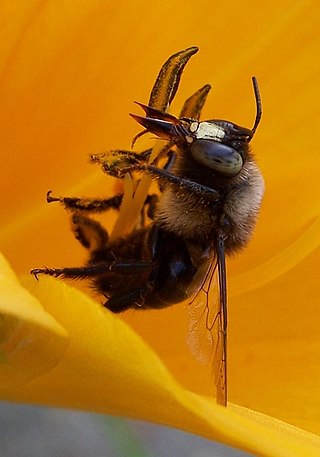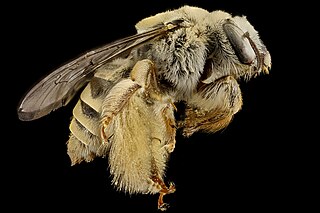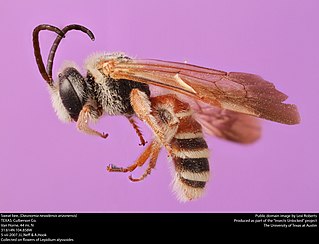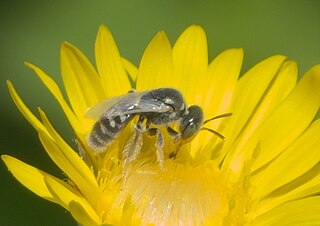
Anthidiini is a tribe of insects in the family Megachilidae. There are at least 40 genera and 840 described species in Anthidiini. There is strong evidence that the tribe is monophyletic.

Dianthidium is a genus of leafcutter, mason, and resin bees in the family Megachilidae. There are at least 20 described species in Dianthidium.
Pseudopanurgus fraterculus is a species of bee in the family Andrenidae. It is found in Central America and North America.

Dieunomia is a genus of sweat bees in the family Halictidae. There are about nine described species in Dieunomia. These bees are relatively uncommon, and are larger than almost every other genus in Halictidae other than Nomia. The wing has two submarginal cells, and the usual bent vein of the basal vein is only weakly present. The male has greatly dilated middle tarsi.

Anthidiellum notatum, the northern rotund resin bee, is a species of bee in the family Megachilidae. It is found in North America.

Rophitinae is a subfamily of sweat bees in the family Halictidae. There are about 13 genera and more than 260 described species in Rophitinae.

Brachynomada is a genus of cuckoo bees in the family Apidae. There are about 16 described species in Brachynomada.

Xenoglossa is a genus of large squash bees in the family Apidae. There are about 11 described species in Xenoglossa.
Oreopasites is a genus of cuckoo bees in the family Apidae. There are about 11 described species in Oreopasites.
Calliopsis puellae is a species of bee in the family Andrenidae. It is found in Central America and North America.

Dianthidium floridiense is a species of bee in the family Megachilidae. It is found in North America.

Panurginus is a genus of bees in the family Andrenidae. There are more than 50 described species in Panurginus.

Xylocopa tabaniformis, the horsefly-like carpenter bee or mountain carpenter bee is a species of carpenter bee in the family Apidae. It is found in Central America, North America, and South America. It is 12–18 millimetres long and black. Males have yellow hair on the thorax.

Diadasia rinconis is a species of chimney bee in the family Apidae. It is found in Central America and North America. In the Sonoran Desert, D. rinconis is considered the "cactus bee" as it feeds almost exclusively on a number of Sonoran Desert cactus species, its life cycle revolving around the flowering of the native species of cacti.

Dieunomia nevadensis, the Nevada nomia, is a species of sweat bee in the family Halictidae. It is found in Central America and North America. It was first described by Ezra Cresson in 1874.

Hylaeus mesillae is a species of bee in the family Colletidae. It is found in Central America and North America.
Perdita gerhardi is a species of bee in the family Andrenidae. It is found in North America.

The shiny green miner bee is a species of miner bee in the family Andrenidae. Another common name for this species is the white-winged perdita. It is found in Central America and North America.

Svastra obliqua, the sunflower bee, is a species of long-horned bee in the family Apidae. It is found in Central America and North America.
Andrena jessicae is a species of mining bee in the family Andrenidae. It is found in Central America and North America. This species is named after Jessie E. Casad, a co-author of Cockerell.














